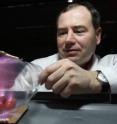Simple device can ensure food gets to the store bacteria free
A Purdue University researcher has found a way to eliminate bacteria in packaged foods such as spinach and tomatoes, a process that could eliminate worries concerning some food-borne illnesses. Kevin Keener designed a device consisting of a set of high-voltage coils attached to a small transformer that generates a room-temperature plasma field inside a package, ionizing the gases inside. The process kills harmful bacteria such as E. coli and salmonella, which have caused major public health concerns.
Keener's process is outlined in an article released online early in LWT - Food Science and Technology, a journal for the Swiss Society of Food and Technology and the International Union of Food Science and Technology.
"Conceptually, we can put any kind of packaged food we want in there," said Keener, an associate professor in the Department of Food Science. "So far, it has worked on spinach and tomatoes, but it could work on any type of produce or other food."
By placing two high-voltage, low-watt coils on the outside of a sealed food package, a plasma field is formed. In the plasma field, which is a charged cloud of gas, oxygen has been ionized and turned into ozone. Treatment times range from 30 seconds to about five minutes, Keener said.
Ozone kills bacteria such as E. coli and salmonella. The longer the gas in the package remains ionized, the more bacteria that are killed. Eventually, the ionized gas will revert back to its original composition.
The process uses only 30-40 watts of electricity, less than most incandescent light bulbs. The outside of the container only increases a few degrees in temperature, so its contents are not cooked or otherwise altered.
Other methods of ozone treatment require adding devices to bags before sealing them to create ozone or pumping ozone into a bag and then sealing it. Keener's method creates the ozone in the already sealed package, eliminating any opportunity for contaminants to enter while ozone is created.
"It's kind of like charging a battery. We're charging that sample," Keener said. "We're doing it without electrode intrusion. We're not sticking a probe in the package. We can do this in a sealed package."
Keener said testing has worked with glass containers, flexible plastic-like food-storage bags and rigid plastics, such as strawberry cartons and pill bottles. He said the technology also could work to ensure pharmaceuticals are free from bacteria.
According to the Centers for Disease Control and Prevention, about 40,000 cases of Salmonellosis, an infection caused by salmonella, are reported each year in the United States, causing 400 deaths. The CDC reports that about 70,000 E. coli infections are reported each year, causing dozens of deaths.
Source: Purdue University
Other sources
- Simple Device Can Ensure Food Gets To The Store Bacteria Freefrom Science DailyThu, 5 Mar 2009, 15:36:01 UTC
- Device kills bacteria in packaged foodsfrom UPIWed, 4 Mar 2009, 17:35:35 UTC
- Simple device can ensure food gets to the store bacteria freefrom PhysorgMon, 2 Mar 2009, 20:36:18 UTC
